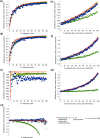Detecting past positive selection through ongoing negative selection
- PMID: 21859804
- PMCID: PMC3184776
- DOI: 10.1093/gbe/evr086
Detecting past positive selection through ongoing negative selection
Abstract
Detecting positive selection is a challenging task. We propose a method for detecting past positive selection through ongoing negative selection, based on comparison of the parameters of intraspecies polymorphism at functionally important and selectively neutral sites where a nucleotide substitution of the same kind occurred recently. Reduced occurrence of recently replaced ancestral alleles at functionally important sites indicates that negative selection currently acts against these alleles and, therefore, that their replacements were driven by positive selection. Application of this method to the Drosophila melanogaster lineage shows that the fraction of adaptive amino acid replacements remained approximately 0.5 for a long time. In the Homo sapiens lineage, however, this fraction drops from approximately 0.5 before the Ponginae-Homininae divergence to approximately 0 after it. The proposed method is based on essentially the same data as the McDonald-Kreitman test but is free from some of its limitations, which may open new opportunities, especially when many genotypes within a species are known.
Figures



References
-
- Andrews RM, et al. Reanalysis and revision of the Cambridge reference sequence for human mitochondrial DNA. Nat Genet. 1999;23:147. - PubMed
-
- Baxevanis AD. Searching NCBI databases using Entrez. Curr Protoc Bioinformatics. 2008;Chapter 1:Unit 1.3. - PubMed
-
- Bazykin GA, Kondrashov FA, Ogurtsov AY, Sunyaev S, Kondrashov AS. Positive selection at sites of multiple amino acid replacements since rat-mouse divergence. Nature. 2004;429:558–562. - PubMed
Publication types
MeSH terms
Substances
LinkOut - more resources
Full Text Sources
Medical
Molecular Biology Databases
Miscellaneous

